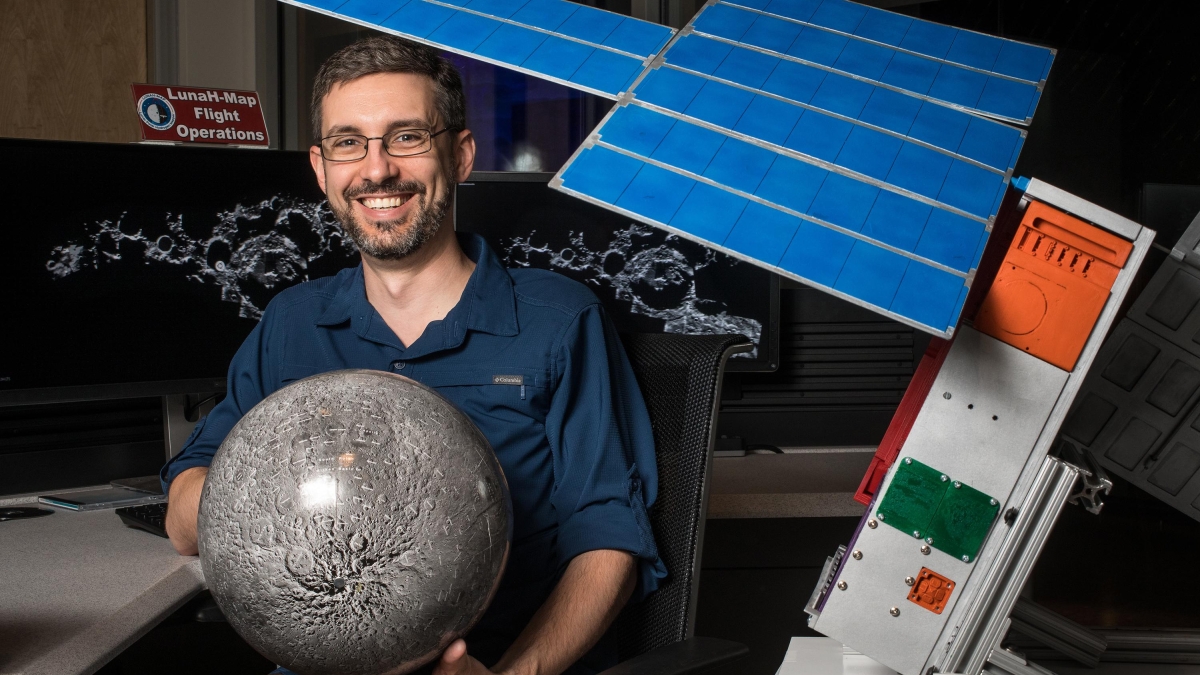55 years of lunar exploration continued by SESE professor

Craig Hardgrove, associate professor at ASU’s School of Earth and Space Exploration, recently celebrated the completion of the LunaH-Map mission to space. Courtesy photo
On July 20, 1969, Neil Armstrong and Buzz Aldrin famously took “one small step for man, one giant leap for mankind” when they became the first individuals to ever set foot on the moon. Fifty-five years later, that legacy of lunar exploration is being continued at Arizona State University.
Craig Hardgrove, associate professor at ASU’s School of Earth and Space Exploration (SESE), recently celebrated the completion of the LunaH-Map mission to space.
“It's very energizing,” said Hardgrove, principal investigator for the mission. “Bringing together private companies, faculty and students was challenging, but I think I'm really happy with how everything turned out.”
The LunaH-Map mission aimed to identify hydrogen enrichments on the surface of the moon. Although it “didn't fulfill the ultimate science goal of making maps of water on the moon,” according to Hardgrove, it was still a success.
“We demonstrated that the instrument was successful at collecting the data that it needed to,” he said. “And we're building on that success with a mission called Lunar-VISE, which is a rover that's landing at a unique, volcanic feature on the moon in 2027.”
Lunar-VISE is set for a 10-day mission to measure the thorium and hydrogen abundance on the lunar surface. Hardgrove and his team are working with the same Tempe-based company, Qwaltec, that assisted with the operations for the LunaH-Map mission to develop ground data systems for Lunar-VISE.
So in addition to the success of the LunaH-Map mission, Hardgrove said, “… a lot of really positive relationships are continuing.”
Hardgrove credits the ASU NewSpace team for enabling these significant commercial opportunities. He is especially appreciative of Jim Bell, director of ASU NewSpace, and Scott Smas, associate director of SESE.
“I can't think of a single connection that really wasn't enabled by relationships that were made by NewSpace,” Hargrove said. “We had a connection with Blue Canyon through NewSpace. Scott also made connections with the solar panel company. And Jim really has his finger on what would be most useful for scientists in the field and how we can reach out to specific scientists.”
In light of LunaH-Map’s success, Hardgrove is especially proud of how it set a precedent of accessibility and financial sustainability unlike other similar missions.
“(Some missions) cost in the billions of dollars,” Hargrove said, “and LunaH-Map costs a fraction of that, a percent of that budget. And the fact that we got so close to being able to achieve a meaningful scientific mission with that fraction is hopefully one of the lasting impressions that people get from missions like this.”
Though he is currently largely occupied with plans for the upcoming Lunar-VISE mission, Hardgrove is still open to the possibility of future partnerships within the space industry.
“I'm always kind of on the lookout for these opportunities that might crop up where there is something that NASA is interested in supporting that can be done at a different and maybe a higher risk posture,” he said. “I'm always on the lookout for missions like LunaH-Map.”
More Science and technology

Damaged moon rocks persuade researchers to rethink lunar history
New research reveals that even lunar samples once believed to be pristine have been extensively altered by meteorite impacts, challenging long-held assumptions about the moon’s formation and early…

CSI: Mars
By Wendee NicoleTravelling to Mars has loomed large in the public’s imagination since at least the late 1800s when H.G. Wells' “War of the Worlds” tale of a Martian invasion was serialized in print.…

ASU research is helping solve crimes
On TV, detectives solve crimes in 43 minutes (plus commercial breaks). In real life, it takes much more time — and many more minds, including researchers discovering new ways to analyze evidence and…

